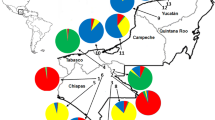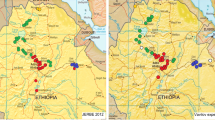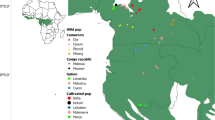Abstract
Einkorn (Triticum monococcum L.) was one of the first cereals to be domesticated in the Old World ca. 10,000 years ago and to spread towards Europe and North Africa. Its cultivation declined before the Iron Age and it remains today only as a relic crop in remote areas. To investigate if the geographic distribution of genetic diversity in modern einkorn landrace accessions could be informative about the movement of this crop during prehistory, we genotyped 50 accessions of einkorn from Europe, North Africa and the Near East. Using nuclear and chloroplast microsatellites and clustering methods, we detected two main gene pools in einkorn. The distribution of these lineages revealed differences between accessions from Morocco and the Iberian Peninsula from the rest of Europe and the Near East and suggests different regional dynamics in the spread of this crop.






Similar content being viewed by others
References
Alonso N (2008) Crops and agriculture during the Iron Age and late antiquity in Cerdanyola del Valle’s (Catalonia, Spain). Veg Hist Archaeob 17:75–84
Antolín F, Buxó R (2010) Durum wheat in the early Neolithic of the Iberian Peninsula: evaluating the evidence from La Draga (Banyoles, Girona Province, Spain). In: Bittmann F (ed) 15th Conference of the International Work Group for Palaeoethnobotany. Verlag/Terra Nostra–Schriften der GeoUnion Alfred-Wegener-Stiftung Wilhelmshaven, Germany
Bai J, Liu K, Jia X, Wang D (2004) An analysis of homoeologous microsatellites from Triticum urartu and Triticum monococcum. Plant Sci 166:341–347
Ballouche A, Marinval P (2003) Donnes palynologiques et carpologiques sur la domestication des plantes et l’agriculture dans le Neolithique ancien du Maroc septentrional (site de Kaf Taht el-Ghar). Revue d’Archaéometrie 27:49–54
Bellwood P (2005) First farmers. Wiley-Blackwell, Oxford
Bogaard A (2004) Neolithic farming in central Europe: an archaeobotanical study of crop husbandry practices. Routledge, London
Brandolini A, Vaccino P, Boggini G, Ozkan H, Kilian B, Salamini F (2006) Quantification of genetic relationships among A genomes of wheats. Genome 49:297–305
Brown TA, Lindsay S, Allaby R (2006) Using modern landraces of wheat to study the origins of European agriculture. In: Motley T, Zerega N, Cross H (eds) Darwin’s harvest. Columbia University Press, New York
Campana MG, Hunt HV, Jones H, White J (2010) CorrSieve: software for summarizing and evaluating Structure output. Mol Ecol Resour 11:349–352
Cavalli-Sforza L, Edwards A (1967) Phylogenetic analysis: models and estimation procedures. Am J Hum Genet 19:233–257
Chessel D, Dufour AB, Thiolouse J (2004) The ade4 package—I: one-table methods. R News 4:1–6
Ducellier L (1921) Contribution a l'étude des espèces du genre Triticum cultivés dans le nord del'Afrique. Bulletin Societé Histoire Natural de Afrique du Nord 12(4):66–68
Eujayl I, Sorrells ME, Baum M, Wolters P, Powell W (2002) Isolation of EST-derived microsatellite markers for genotyping the A and B genomes of wheat. Theor Appl Genet 104:399–407
Evanno G, Regnaut S, Goudet J (2005) Detecting the number of clusters of individuals using the software STRUCTURE: a simulation study. Mol Ecol 14:2611–2620
Falush D, Stephens M, Pritchard J (2007) Inference of population structure using multilocus genotype data: dominant markers and null alleles. Mol Ecol Notes 7(4):574–578
Fuller DQ (2007) Contrasting patterns in crop domestication and domestication rates: recent archaeobotanical insights from the Old World. Ann Bot 100:903–924
Fulton TM, Chunzoongse J, Tanksley SD (1995) Microprep protocol for extraction of DNA from tomato and other herbaceous plants. Plant Mol Biol Rep 13(3):207–209
Halstead P (1996) The development of agriculture and pastoralism in Greece: when, how, who and what? In: Harris DR (ed) The origins and spread of agriculture and pastoralism in Eurasia: crops. Fields, Flocks and Herds, Routledge
Hammer K, Filatenko AA, Korzun V (2000) Microsatellite markers—a new tool for distinguishing diploid wheat species. Genet Resour Crop Evol 47:497–505
Heun M, Schäfer-Pregl R, Klawan D, Castagna R, Accerbi M, Borghi B, Salamini F (1997) Site of einkorn domestication identified by DNA fingerprinting. Science 278:1312–1314
Heun M, Haldorsen S, Vollan K (2008) Reassessing domestication events in the Near East: einkorn and Triticum urartu. Genome 51(6):444–451
Hillman G (2000) Plant food economy of Abu Hureyra. In: Moore A, Hillman G, Legge T (eds) Village on the Euphrates, from foraging to farming at Abu Hureyra. Oxford University Press, Oxford
Hood G (2002) Poptools 3.2. Available at http://www.cse.csiro.au/poptools
Huson DH, Richter DC, Rausch C, Dezulian T, Franz M, Rupp R (2007) Dendroscope: an interactive viewer for large phylogenetic trees. BMC Bioinforma 8:460
Isaac AD, Muldoon M, Brown KA, Brown TA (2010) Genetic analysis of wheat landraces enables the location of the first agricultural sites in Italy to be identified. J Archaeol Sci 37:950–956
Ishii T, Mori N, Ogihara Y (2001) Evaluation of allelic diversity at chloroplast microsatellite loci among common wheat and its ancestral species. Theor Appl Genet 103:896–904
Jacomet S (2007) Neolithic plant economies in the northern Alpine Foreland from 5500–3500 cal BC. In: Colledge S, Conolly J (eds) The origins and spread of domestic plants in Southwest Asia and Europe. Left Coast Press, Walnut Creek
Jombart T (2008) adegenet: a R package for the multivariate analysis of genetic markers. Bioinformatics 24:1403–1405
Jones M, Allaby RJ, Brown TA (1998) Wheat domestication. Science 279:303
Jones H, Lister DL, Bower MA, Leigh FJ, Smith LM, Jones MK (2008) Approaches and constraints of using existing landrace and extant plant material to understand agricultural spread in prehistory. Plant Genet Resour 6(2):98–112
Kilian B, Ozkan H, Walther A, Kohl J, Dagan T, Salamini F, Martin W (2007) Molecular diversity at 18 loci in 321 wild and 92 domesticate lines reveal no reduction of nucleotide diversity during Triticum monococcum (einkorn) domestication: implications for the origin of agriculture. Mol Biol Evol 24(12):2657–2668
Kreuz A (2007) Archaeobotanical perspectives on the beginning of agriculture north of the Alps. In: Colledge S, Conolly J (eds) The origins and spread of domestic plants in Southwest Asia and Europe. Left Coast Press, Walnut Creek
Kreuz A, Boenke N (2002) The presence of two-grained einkorn at the time of the Bandkeramik culture. Veg Hist Archaeob 11:233–240
Kroll H (2007) The plant remains from the Neolithic Funnel Beaker site of Wangels in Holsatia, Northern Germany. In: Colledge S, Conolly J (eds) The origins and spread of domestic plants in Southwest Asia and Europe. Left Coast Press, Walnut Creek
Linstädter J (2008) The Epipalaeolithic–Neolithic-transition in the Mediterranean region of Northwest Africa. Quartär 55:41–62
Lister DL, Bower MA, Jones MK (2010) Herbarium specimens expand the geographical and temporal range of germplasm data in phylogeographic studies Taxon 59: 1321–1323
Liu J, Muse SV (2005) PowerMarker: an integrated analysis environment for genetic marker analysis. Bioinformatics 21(9):2128–2129
Londo JP, Chiang Y-C, Hung K-H, Chiang T-Y, Schaal BA (2006) Phylogeography of Asian wild rice, Oryza rufipogon, reveals multiple independent domestications of cultivated rice, Oryza sativa. Proc Natl Acad Sci USA 103:9578–9583
Lund B, Ortiz R, Skovgaard I, Waugh R, Andersen S (2003) Analysis of potential duplicates in barley gene bank collections using re-sampling of microsatellite data. Theor Appl Genet 106(6):1129–1138
Luo M-C, Yang Z-L, You F, Kawahara T, Waines J, Dvorak J (2007) The structure of wild and domesticated emmer wheat populations, gene flow between them, and the site of emmer domestication. Theor Appl Genet 114:947–959
Malone C (2003) The Italian Neolithic: a synthesis of research. J World Prehist 17(3):235–312
Mantel N (1967) Detection of disease clustering and generalised regression approach. Cancer Res 27:209–220
Marinova E (2007) Archaeobotanical data from the early Neolithic of Bulgaria. In: Colledge S, Conolly J (eds) The origins and spread of domestic plants in Southwest Asia and Europe. Left Coast Press, Walnut Creek
Martinez NA (2005) Agriculture and food from the Roman to the Islamic Period in the North-East of the Iberian Peninsula: archaeobotanical studies in the city of Lleida (Catalonia, Spain). Veg Hist Archaeob 14:341–361
Miège E (1924a) Sur les divers Triticum cultivés au Maroc. Bulletin de la Société des Sciences Naturelles du Maroc 4(5–6):135–138
Miège E (1924b) Les formes marocaines de Triticum monococcum Linné. Bulletin de la Société des Sciences Naturelles du Maroc 4(7):154–160
Milisauskas S (2001) Linear pottery. In: Peregrine PN, Ember M (eds) Encyclopedia of prehistory vol. 4 Europe. Kluwer Academic, London
Moragues M, Moralejo M, Sorrels M, Royo C (2007) Dispersal of durum wheat [Triticum turgidum L. ssp. turgidum convar. durum (Desf.) MacKey] landraces across the Mediterranean basin assessed by AFLPs and microsatellites. Genet Resour Crop Evol 54:1133–1144
Néron B, Ménager H, Maufrais C, Joly N, Maupetit J, Letort S, Carrere S, Tuffery P, Letondal C (2009) Mobyle: a new full web bioinformatics framework. Bioinformatics 25:3005–3011
Nesbitt M (2002) When and where did domesticated cereals first occur in southwest Asia? In: Cappers R, Bottema S (eds) The dawn of farming in the Near East. Ex Oriente, Berlin
Nesbitt M, Samuel D (1995) From staple crop to extinction? The archaeology and history of hulled wheats. In: Padulosi S, Hammer K, Heller J (eds) Proceedings of the First International Workshop on Hulled Wheats, 21–22 July, Castelvecchio Pascoli, Tuscany, Italy
Oliveira HR (2011) Archaeogenetics and the spread of agriculture in the Iberian Peninsula and Northwest Africa: a study of genetic variation within tetraploid and diploid wheats. Ph.D. dissertation, University of Cambridge, Cambridge, UK
Olsen K, Schaal B (1999) Evidence on the origin of cassava: phylogeography of Manihot esculenta. Proc Natl Acad Sci USA 96:5586–5591
Pelling R (2007) Agriculture and trade amongst the Garamantes: 3000 years of archaeobotanical data from the Sahara and its margins. Ph.D. dissertation, Institute of Archaeology, UCL, London, UK
Peña-Chocarro L (1995) In-situ conservation of hulled wheat species: the case of Spain. In: Padulosi S, Hammer K, Heller J (eds) Proceedings of the First International Workshop on Hulled Wheats, 21–22 July, Castelvecchio Pascoli, Tuscany, Italy
Peña-Chocarro L (2007) Early agriculture in central and southern Spain. In: Colledge S, Conolly J (eds) The origins and spread of domestic plants in Southwest Asia and Europe. Left Coast Press, Walnut Creek
Pena-Chocarro L, Zapata Pena L, Gonzalez-Urquijo JE, Estevez JJI (2009) Einkorn (Triticum monococcum L.) cultivation in mountain communities of the western Rif (Morocco): an ethnoarchaeological project. In: Fairbairn AS, Weiss E (eds) From foragers to farmers: papers in honour of Gordon C. Hillman. Oxbow Books, London
Pozzi C, Salamini F (2007) Genomics of wheat domestication. In: Varshney RK, Tuberosa R (eds) Genomic assisted crop improvement: vol 2: genomics applications in crops., pp 453–481
Pozzi C, Rossini L, Vecchietti A, Salamini F (2004) Gene and genome changes during domestication. In: Gupta PK, Varshney RK (eds) Cereal genomics. Kluwer Academic, London, pp 165–198
Price DT (ed) (2000) Europe’s first farmers. Cambridge University Press, Cambridge
Pritchard JK, Stephens M, Donnelly P (2000) Inference of population structure using multilocus genotype data. Genetics 155:945–959
Provan J, Wolters P, Caldwell KH, Powell W (2004) High-resolution organellar genome analysis of Triticum and Aegilops sheds new light on cytoplasm evolution in wheat. Theor Appl Genet 108:1182–1190
Robinson DE (2007) Exploitation of plant resources in the Mesolithic and Neolithic of southern Scandinavia: from gathering to harvesting. In: Colledge S, Conolly J (eds) The origins and spread of domestic plants in Southwest Asia and Europe. Left Coast Press, Walnut Creek
Röder MS, Korzun V, Wendehake K, Plaschke J, Tixier M-HLN, Leroy P, Ganal MW (1998) A microsatellite map of wheat. Genetics 149:2007–2023
Rossiter S, Benda P, Dietz C, Zhang S, Jones G (2007) Rangewide phylogeography in the greater horseshoe bat inferred from microsatellites: implication for population history, taxonomy and conservation. Mol Ecol 16:4699–4714
Rottoli M, Castiglioni E (2009) Prehistory of plant growing and collecting in northern Italy, based on seed remains from the early Neolithic to the Chalcolithic (c. 5600–2100 cal B.C.). Veg Hist Archaeob 18:91–103
Rottoli M, Pessina A (2007) Neolithic agriculture in Italy: an update of archaeobotanical data with particular emphasis on northern settlements. In: Colledge S, Conolly J (eds) The origins and spread of domestic plants in Southwest Asia and Europe. Left Coast Press, Walnut Creek
Ruiz M, Aguiriano E, Fité R, Carrillo JM (2007) Combined use of gliadins and SSRs to analyse the genetic variability of the Spanish collection of cultivated diploid wheat (Triticum monococcum L. ssp. monococcum). Genet Resour Crop Evol 54:1849–1860
Saisho D, Purugganan MD (2007) Molecular phylogeography of domesticated barley traces expansion of agriculture in the Old World. Genetics 177:1765–1776
Saitou N, Nei M (1987) The neighbour-joining method: a new method for reconstructing phylogenetic trees. Mol Biol Evol 4:406–425
Salamini F, Ozkan H, Brandolini A, Schafer-Pregl R, Martin W (2002) Genetics and geography of wild cereal domestication in the Near East. Nat Rev Genet 3:429–441
Schuelke M (2000) An economic method for the fluorescent labelling of PCR fragments. Nat Biotechnol 18:233–234
Sjörgen P, Wyöni P-I (1994) Conservation genetics and detection of rare alleles in finite population. Conserv Biol 8(1):267–270
Sourdille P, Tavaud M, Charmet G, Bernard M (2001) Transferability of wheat microsatellites to diploid Triticeae species carrying the A, B and D genomes. Theor Appl Genet 103:346–352
Taylor JA (2005) Muslims in Medieval Italy: the colony at Lucera. Lexington Books, Oxford
Tereso JP (2009) Plant macrofossils from the Roman settlement of Terronha de Pinhovelo, northwest Iberia. Veg Hist Archaeob 18:489–501
Thuillet A-C, Bataillon T, Poirier S, Santoni S, David JL (2005) Estimation of long-term effective population sizes through the history of durum wheat using microsatellite data. Genetics 169:1589–1599
Valamoti S-M, Kotsakis K (2007) Transitions to agriculture in the Aegean: the archaeobotanical evidence. In: Colledge S, Conolly J (eds) The origins and spread of domestic plants in Southwest Asia and Europe. Left Coast Press, Walnut Creek
Willcox G (2004) Measuring grain size and identifying Near Eastern cereal domestication: evidence from the Euphrates valley. J Archaeol Sci 31:145–150
Yahiaoui S, Igartua E, Moralejo M, Ramsay L, Molina-Cano JL, Ciudad FJ, Lasa JM, Garcia MP, Casas AM (2008) Patterns of genetic and eco-geographical diversity in Spanish barley. Theor Appl Genet 116:271–282
Zapata L, Peña-Chocarro L, Pérez-Jordá G, Stika H-P (2004) Early Neolithic agriculture in the Iberian peninsula. J World Prehist 18:283–325
Zhang H, Stern H (2009) Inferences for genotyping error rate in ancestry identification from simple sequence repeat marker profiles. J Agric Biol Environ Stat 14(2):170–187
Zhang LY, Ravel C, Bernard M, Balfourier F, Leroy P, Feuillet C, Sourdille P (2006) Transferable bread wheat EST-SSRs can be useful for phylogenetic studies among the Triticeae species. Theor Appl Genet 113:407–418
Zohary D, Hopf M (2000) Domestication of plants in the Old World. Oxford University Press, Oxford
Acknowledgments
This works has been funded by a Ph.D. grant (ref. SFRH/BD/21748/2005) attributed to HO by the Portuguese Science and Technology Foundation, by the European Research Council (Advanced Grant No. 2305619) project Origins and spread of agriculture in the western Mediterranean Region and the Spanish project Orígenes y expansión de la agricultura en el sur peninsular y norte de Marruecos: aportaciones desde la arqueobotánica y la genética HAR2008-09120/HIST (Plan Nacional de I+D+i) coordinated by LPCH. The authors are thankful for the germplasm collections that contributed the necessary seed material.
Author information
Authors and Affiliations
Corresponding author
Rights and permissions
About this article
Cite this article
Oliveira, H.R., Jones, H., Leigh, F. et al. Phylogeography of einkorn landraces in the Mediterranean basin and Central Europe: population structure and cultivation history. Archaeol Anthropol Sci 3, 327–341 (2011). https://doi.org/10.1007/s12520-011-0076-x
Received:
Accepted:
Published:
Issue Date:
DOI: https://doi.org/10.1007/s12520-011-0076-x




